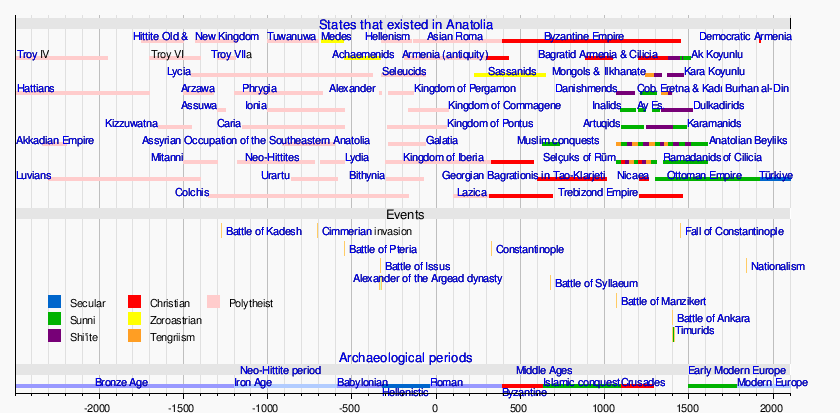Assuwa
| Formation | fl. 1400 BC |
|---|---|
| Type | Confederation or league comprising several states. |
| Location |
|
Membership | 22 |
Assuwa was a confederation (or league) of 22 ancient Anatolian states that formed some time before 1400 BC, when it was defeated by the Hittite Empire, under Tudhaliya I. The league was formed to oppose the Hittites. A successor state, in a similar area, was named Arzawa. The historian H. T. Bossert suggested that Assuwa may have been the origin of the name Asia (which was used initially only in reference to Asia Minor).[1]
Modern scholars have often located Assuwa only in the north-west corner of Anatolia, an area centred north or north-west of the future Arzawa. This has made the inclusion of Caria, Lukka and/or Lycia problematic, as they were clearly located in south-west Anatolia. Their inclusion would mean that Assuwa included areas both north and south of Arzawa. However, the confederative structure of Assuwa may well have included states in two or more geographically separate, non-contiguous areas, which lacked a common land border.
Members
The member states are said to have included (in the order that they were listed by Tudhaliya I):
- a name ending in -ugga (or -luqqa),
- Kišpuwa,
- Unaliya,
- an obliterated name,
- Dura,
- Ḥalluwa,
- Ḥuwallušiya,
- Karakiša,
- Dunda,
- Adadura,
- Parišta,
- an obliterated name,
- a name probably ending in -wwa,
- Waršiya,
- Kuruppiya,
- a name ending in -luišša (or the whole name Luišša),
- a name that is probably Alatra,
- "the land of Mount Pahurina",
- Pasuhalta,
- an obliterated name,
- Wilušiya,
- and T[a]rui[s]ša.
In most cases, these states are never (or seldom) mentioned in the few contemporaneous sources available. However, Karkiya has generally been identified with Caria, Taruisa with the Troas (Troad) peninsula, and Wilusiya with Wilusa – which was apparently the endonym of the city known to the Ancient Greeks as Troy (or Ilios). The historical Lycia and/or Lukka have frequently been identified with Warsiya and [L]ugga. For instance, in the Iliad, Homer refers to two separate areas as "Lycia": Sarpedon is a leader of "distant Lycia" (in 2.876-77, 5.479) and Pandarus is the leader of Lycians from around Mount Ida (2.824ff. 5.105). Likewise the Alaksandu Treaty identifies Warsiyalla with the Lukka.
History
The confederacy is mentioned only in the fragmentary tablets making up Laroche's CTH 142/85. Since Tudhaliya IV was known to have had frontier trouble between 1250 and 1200 BC, and since the text lists rebel nations in much the way Ramesses II does, the first consensus dated this text and, therefore, Assuwa to Tudhaliya IV. This dating appears in all older literature on the fall of the Hatti, and crops up every now and then to this day. However the consensus has since then come around to dating Assuwa to an earlier Tudhaliya, which means prior to Suppiluliuma and so prior to 1350 BC.
A number of fragmentary Hittite records imply that the anti-Hittite rebellion of the Assuwa league received a certain decree of support from Mycenaean Greece (Ahhiyawa in Hittite).[2]
References
- Bossert, Helmut T, Asia, Istanbul, 1946.
- ↑ H. T. Bossert, 1946, Asia, vol.?, pp. ?.
- ↑ Castleden, Rodney (2005). The Mycenaeans. Routledge. pp. 202–203. ISBN 9781134227822.
It was political instability of this kind, not just in Assuwa but all along the Aegean coast, that the Mycenaeans were able to exploit. One fragmentary letter mentions Assuwa and Ahhiyawa together, implying that the rebellion of Assuwa may have been supported by the Mycenaeans. Another (ambiguous) letter says ‘the king of Ahhiyawa withdrew or retreated’ or someone ‘relied on the king of Ahhiyawa’, so the Mycenaean king was either leading his army in Anatolia or supporting rebellion from afar.
